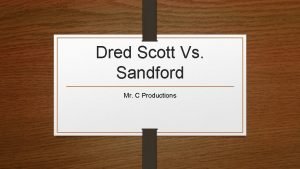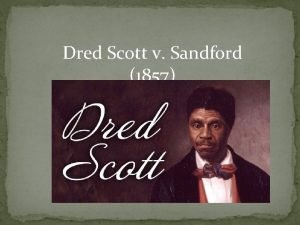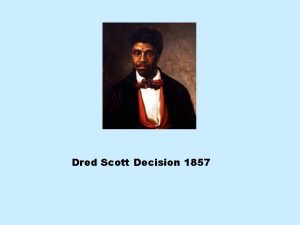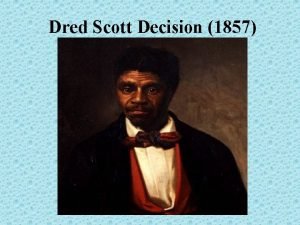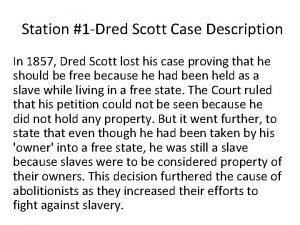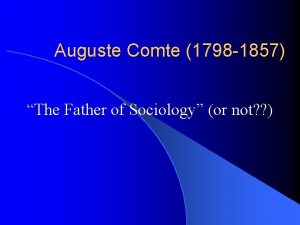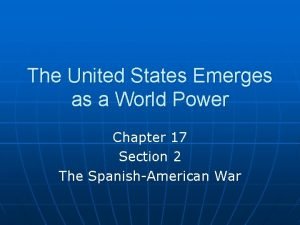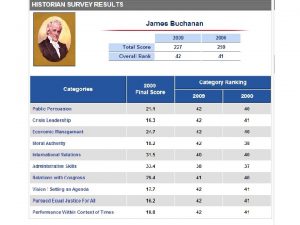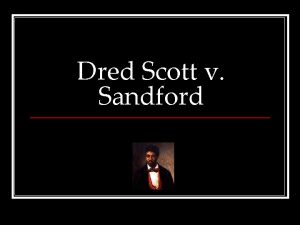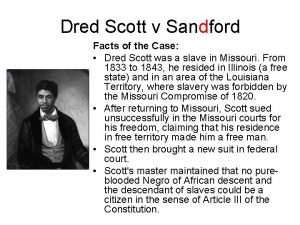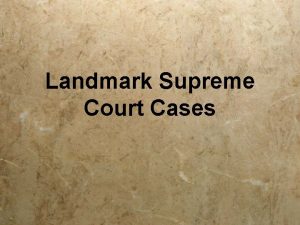Dred Scott v Sandford 1857 Define the following















- Slides: 15

Dred Scott v. Sandford (1857)

Define the following term: PROPERTY List as many examples as you can of property

What would you do? Read the scenario below and write your response on the Dred Scott Case Study Response Sheet You live in South Carolina where they allow unlimited use of earbuds with your cell phone. You then move with your family to Pennsylvania, a state where using earbuds with your cell phone is not allowed. Later, after several years, you move back to South Carolina. Do the earbuds still belong to you? Why or why not? Scenario – Part 1

What would you do? Read the scenario below and write your response on the Dred Scott Case Study Response Sheet Does Congress have the right to say that you cannot use your earbuds in s South Carolina (a state that allows earbud usage), since they had “lived” in Pennsylvania (a state that does not allow earbud usage) for so long? Why or why not? Scenario – Part 2

Public Policy Analysis – 4 Steps Define the Problem Gather the Evidence Identify the Causes Evaluate the Policy

Who was Dred Scott? Dred Scott was born into slavery some time in 1795 in Virginia. He was sold to Dr. John Emerson some time between 1830 and 1833 (some historians believe 1831 when Emerson moved to St. Louis, Missouri). With Dr. Emerson, Scott traveled from Missouri to the free state of Illinois, where Emerson was stationed for about 3 years. Then they moved to Ft. Snelling in the free territory of Wisconsin before returning to St. Louis, MO. After a delayed relocation to another slave state, Louisiana, Emerson returned with Scott to St. Louis in 1842. Dr. Emerson died in 1843 at which point Scott and his family became part of Emerson’s estate which he left to his wife, Irene Emerson. Her brother John Sanford handled her affairs. In April 1846 Scott filed a petition with the St. Louis Circuit Court for his freedom. The case would be in and out of the court system until reaching the US Supreme Court in 1856. The final decision on Scott’s freedom from slavery would be delivered by the Supreme Court on March 6, 1857.

Who was Dr. John Emerson? Dr. John Emerson was Scott’s owner. He moved to St. Louis, Missouri some time before 1831. He was a civilian doctor Jefferson Barracks, a US military post in St. Louis. On October 25, 1833 Emerson accepted an appointment as an assistant surgeon in the US Army. Historical records showing the sale of Scott to Emerson are unclear. Something to note, as part of the military Emerson was assigned to move around the US. He did not chose to move to free states/territories on his own.

Public Policy Analysis – 4 Steps Define the Problem Gather the Evidence Identify the Causes Evaluate the Policy

Emerson is stationed in Missouri – A Slave State Emerson is transferred to Illinois – A Non-Slave State Emerson is transferred to Wisconsin Territory – A Non-Slave Territory Emerson is transferred back to Missouri – A Slave State He passes away shortly after.

A tale of 2 Sides………. VS. Dred Scott � Lived in non-slave holding state and territory long enough to be considered free � When Emerson passed away he no longer had an owner US Supreme Court � Dred Scott did not have the protections of US citizenship because he was a slave � Congress does not have the right to control the property of it’s citizens

You be the judge (or justice)………. q Which side do you think should win this case? q What evidence would you use to support your side? q Consider everything you have learned so far about Dred Scott and his journey to the Supreme Court.

The Supreme Court Ruling………. Dred Scott v. Sandford (1857) Court’s Decision: � In March of 1857, Scott lost the decision as seven out of nine Justices on the Supreme Court declared no slave or descendant of a slave could be a U. S. citizen, or ever had been a U. S. citizen. As a non-citizen, the court stated, Scott had no rights and could not sue in a Federal Court and must remain a slave. Constitutional Facts: � The Supreme Court also ruled that Congress could not stop slavery in the newly emerging territories and declared the Missouri Compromise of 1820 to be unconstitutional. The Missouri Compromise prohibited slavery north of the parallel 36° 30´ in the Louisiana Purchase. The Court declared it violated the Fifth Amendment of the Constitution which prohibits Congress from depriving persons of their property without due process of law.

Public Policy Analysis – 4 Steps Define the Problem Gather the Evidence Identify the Causes Evaluate the Policy

You be the judge………. of the Supreme Court q Did the Supreme Court in 1857 make the right decision? q Things to think about when forming your opinion: q Consider the law – look at the ruling and consider the Constitutional evidence presented q Consider the arguments – did Scott have a strong enough argument to gain his freedom? Op-Ed (Opinion Editorial ) Writing : Write an opinion article about whether or not you support the Supreme Court Ø Claim = a statement of your opinion supporting Dred Scott or the Supreme Court (This is 1857 so it’s ok to argue either side – stay in character!) Ø Data = include evidence from the case study to support your opinion Ø Warrant = Final statement of your opinion including why people should agree with you.

Dred Scott Case: Cause of the Civil War? – Exit Ticket Should this event be considered a cause of the American Civil War? Defend your choice with specific facts/details/examples from what you learned so far.
 Dred scott vs. sandford 1857
Dred scott vs. sandford 1857 Define dred scott
Define dred scott Dred scott vs sandford facts
Dred scott vs sandford facts Dred scott childhood
Dred scott childhood Dred scott decision what happened
Dred scott decision what happened Quizlet
Quizlet Preston brooks
Preston brooks Dred scott case description
Dred scott case description Mollie fitzgerald wikipedia
Mollie fitzgerald wikipedia The british administrative structure in india(1765-1857)
The british administrative structure in india(1765-1857) Project on revolt of 1857
Project on revolt of 1857 Présentation
Présentation Auguste comte parents
Auguste comte parents Revolt of 1857 to 1947
Revolt of 1857 to 1947 Padre de la lingüística
Padre de la lingüística United states acquisitions and annexations 1857-1904
United states acquisitions and annexations 1857-1904
